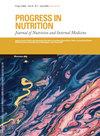成人2型糖尿病患者血浆总抗氧化能力与膳食抗氧化状态的关系
4区 医学
Q4 Agricultural and Biological Sciences
引用次数: 2
摘要
背景和目的:关于糖尿病患者血浆总抗氧化能力(TAC)与膳食TAC的关系,现有信息有限。本研究的目的是评估成人2型糖尿病患者血浆TAC及其与膳食抗氧化状态的关系。方法:30名门诊诊断为2型糖尿病的患者(糖尿病患者,n=29)和15名健康受试者(对照组,n=15),年龄40-70岁,BMI≤30kg/m2。对能量和营养摄入、人体测量、饮食和血浆TAC以及一些生化参数进行了评估。膳食TAC的计算基于先前公布的数据库,其中FRAP的修改版本。结果:糖尿病患者血清甘油三酯、尿酸和糖化血红蛋白水平均高于对照组。糖尿病患者的血浆TAC和HbA1c之间存在负相关且具有统计学意义。糖尿病患者的膳食TAC、HbA1c和空腹血糖之间存在负相关且具有统计学意义。糖尿病患者血浆TAC与烟酸摄入量呈正相关,且具有统计学意义。两组的膳食TAC和血浆TAC均无显著差异。结论:本研究提供的证据表明,饮食TAC不是糖尿病患者抗氧化状态的重要调节因子。但是,研究表明,食物中烟酸和抗氧化剂的增加可以有效控制糖化血红蛋白和空腹血糖。本文章由计算机程序翻译,如有差异,请以英文原文为准。
The relationship between plasma total antioxidant capacity and dietary antioxidant status in adults with type 2 diabetes
Background and aim: There is limited information available on the association of plasma total antioxidant capacity (TAC) with dietary TAC in DM. The aim of this study was to evaluate the plasma TAC and its association with dietary antioxidant status in adults with Type 2 diabetes. Methods: Thirty outpatients diagnosed with type 2 DM (diabetics, n = 29) and 15 healthy subjects (control, n = 15) aged 40-70 with BMI≤ 30 kg/m2 were recruited to the study. Energy and nutrients intake, anthropometric measurements, dietary and plasma TAC, and some biochemical parameters were evaluated. The calculation of dietary TAC was based on previously published databases in which modified version of the FRAP. Results: Serum triglyceride, uric acid, and HbA1c levels in diabetics were higher than controls. A negative and statistically significant correlation was found between plasma TAC and HbA1c for diabetics. A negative and statistically significant correlation was observed between dietary TAC, HbA1c and fasting plasma glucose in diabetics. A positive and statistically significant correlation was found between plasma TAC and dietary intake of niacin in diabetics. No remarkable differences were found between dietary and plasma TAC in either group.Conclusion: This study provides evidence that dietary TAC is not an important modulator of antioxidant status in diabetic subjects. But, it showed that the increase in niacin and antioxidant taken with foods can be effective in controlling HbA1c and fasting plasma glucose.
求助全文
通过发布文献求助,成功后即可免费获取论文全文。
去求助
来源期刊

Progress in Nutrition
医学-营养学
CiteScore
1.40
自引率
0.00%
发文量
0
审稿时长
>12 weeks
期刊介绍:
Progress in Nutrition was founded in 1999 as an independent magazine, a multidisciplinary approach, dedicated to issues of nutrition and metabolism.
 求助内容:
求助内容: 应助结果提醒方式:
应助结果提醒方式:


